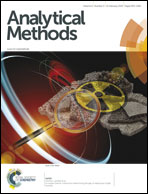Immunolabeling of fingermarks left on forensic relevant surfaces, including thermal paper
Abstract
The chemical composition of a fingermark contains donor profiling information. Immunolabeling is a technique that can be used to retrieve this chemical information from fingermarks. Additionally, immunolabeling can be used to (re)develop fingermarks. To be of interest in the forensic field, the applicability of immunolabeling should be highly diverse. Therefore, in this study we investigated the applicability of one such method: immunolabeling of fingermarks left on non-porous (aluminum foil, stainless steel keys, plastic sheets, different colored garbage bags, sandwich bags, Ziploc bags), semi-porous (tiles, laminated chipboard), and porous surfaces (thermal and copy paper). Successful immunolabeling of specific components in fingermarks was possible on all surfaces tested, except for laminated chipboards and copy paper. Additionally, high quality images could be obtained from the immunolabeled fingermarks. Surprisingly, fingermarks left on thermal paper showed improved visibility when developed with the immunolabeling method. In conclusion, one intrinsically similar immunolabeling method can visualize fingermarks left on non-porous, semi-porous and porous surfaces.


 Please wait while we load your content...
Please wait while we load your content...